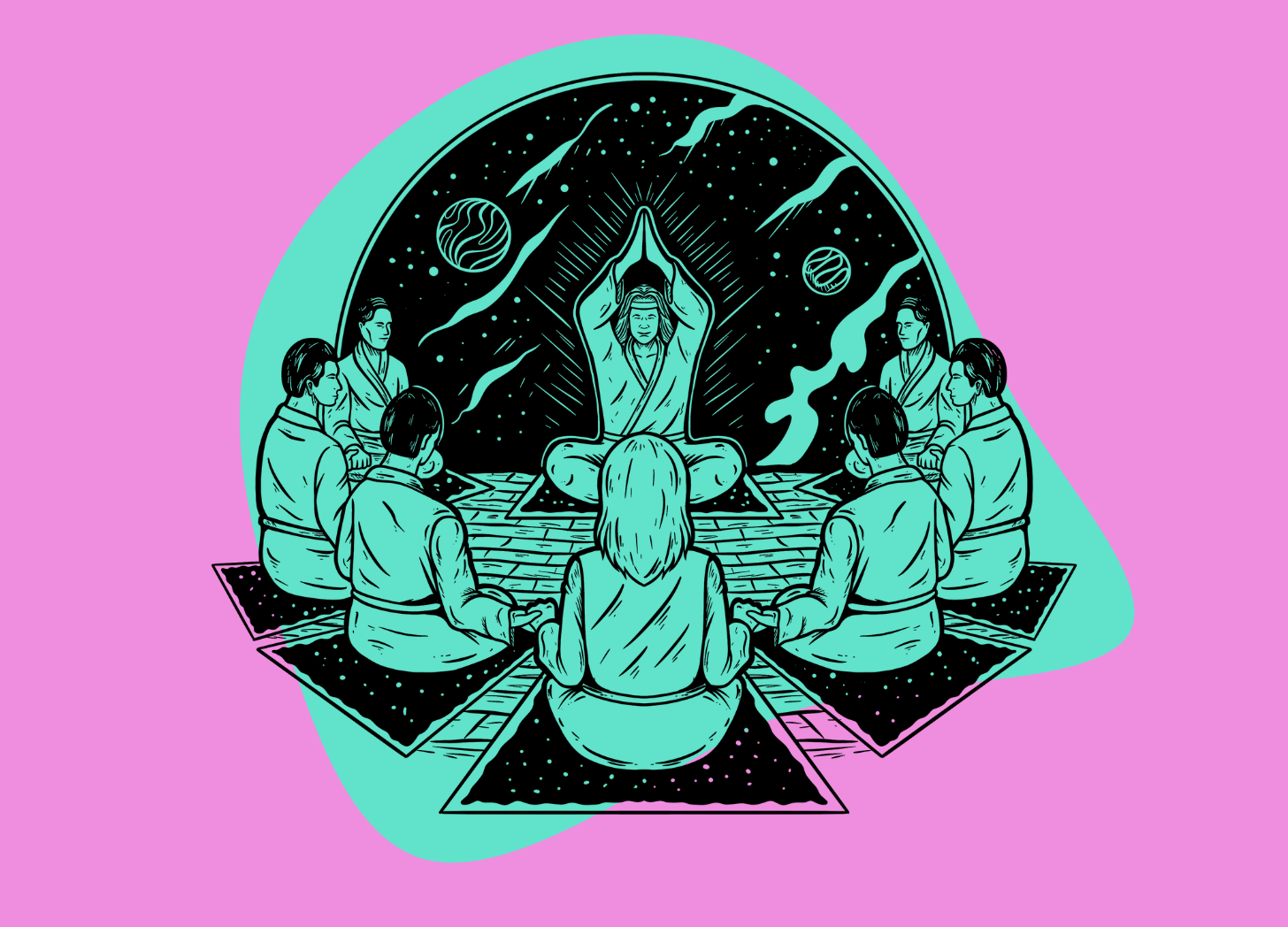The Buenos Aires Yoga Cult: A Masterclass in Manipulation
The Buenos Aires Yoga School scandal reveals classic signs of high-control tactics. From manipulation to corruption, it’s a case study in spotting the red flags of cult behavior.
There’s no shortage of cult stories surrounding the spiritual search for happiness and personal development. There’s also no shortage of spiritual groups that have been unethically prosecuted due to ideological intolerance.
For the past 30 years or so, the Buenos Aires Yoga School (BAYS) has been at the center of social and legal scrutiny due to claims of brainwashing and coercion, sexual exploitation, and an array of illegal business endeavors.
Unlike other infamous cults, however, the BAYS case is a messy legal entanglement with accusations of corruption and human rights violations from all involved — this includes BAYS, the prosecution, the Argentinian justice system, and the government as a whole.
The (still) unresolved case has become a controversial and polarizing conspiratorial scandal where the lines between fact and fiction are blurred beyond recognition.
By analyzing the Buenos Aires Yoga School (BAYS) through the lens of classic cult identifiers, such as those outlined in the BITE Model (which we explore later on), we can better understand the controversies surrounding this polarizing group.
What is the Buenos Aires Yoga School?
The Buenos Aires Yoga School was informally founded by Juan Percowicz in the 80s when a group of friends petitioned him to start teaching Raja yoga classes.
The promise of happiness, healing, and enlightenment led the group to a quick growth spur, gathering roughly 300 consistent members in attendance, with another 700 or so appearing sporadically.
As time passed and the popularity of the BAYS grew, many well-known public figures came to be involved with the institution. Among these were violinist Ruben González and opera singer Placido Domingo. Other classical artists of the time involved with BAYS included Veronica Loiacono, Susana Mendelievich, and Mariano Krauz.
In 1990, the core group of BAYS bought a piece of land and developed new lecture spaces and residences for students. A few years later, it was legally incorporated as the “Fundación Escuela de Yoga de Buenos Aires.”
The school offered philosophy lectures, spaces for artistic expression, community rituals, and mentorship.
Timeline of Events: BAYS History of Legal Battles
BAYS has had several scandals since the early 90s.
Before we get into the details of BAYS specific red flags, here's a brief timeline of some of the legal events surrounding the school over the past few decades:
[1993] Complaints of Brainwashing & Sexual Exploitation
A group of concerned parents filed a complaint claiming that the group was “brainwashing” their children and engaging in sexual exploitation of students. Following these allegations, the school remained active but refused to accept new students for a while.
[1999-2000] USA House of Representatives Accuse Argentina Justice of Harassment Against BAYS & Urges for Case Closure
A series of government resolutions show concern regarding the handling of the BAYS case by the Argentinian government. The USA House of Representatives claimed that the Argentinian justice system was based on corrupt antisemitic motivations and that their prosecution of BAYS was in violation of human rights.
They asked for a prompt resolution and closure of the case.
[2000] Charges Dropped
The case was dropped, and all charges were cleared due to lack of evidence.
The case lost momentum due to long setbacks, procedural difficulties, and staff changes. However, many continued to accuse the Argentinian justice system of corruption and manipulation linked to the case.
Ariel Lijo, the judge who managed the case before charges were dropped, has said on the matter:
“The people are the same, the decisions are the same, the activities are similar, but there are two very important laws now with big penalties that prohibit the core activities these people were doing,”
[August 2022] New Complaint Leads to Building Raid & Multiple Arrests
Pablo Salum, a previous student of the school who participated in the first complaint, filed a new complaint, which caught the attention of the special prosecutors’ office against human trafficking (PROTEX). They ordered a raid of the building and other properties to search for evidence regarding prostitution and other accusations.
19 members, including Percowicz, were arrested in the raid. All assets, including 37 properties, 13 automobiles, and the equivalent of 1 million USD, were embargoed.
The accused faced charges regarding sex trafficking, aggravated robbery, illicit association, non-licensed medical practice, influence peddling, and money laundering.
[November 2022] Confirmed Indictments & Call for a Hearing with Alleged Victims
17 indictments were confirmed by the court of appeals, but all detainees were ordered to be released.
They called for a hearing with 9 alleged victims presented by the prosecutors who denied being involved or forced into prostitution. The court requested a psychiatric evaluation for each of them.
[August 2023] The Hearing Produced No Useful Evidence
The alleged victims were found to be believable and in good mental health. They denied any crime against them. However, the prosecution still claims they are acting under coercive persuasion.
Coercive persuasion, as identified in the BITE Model, includes tactics such as instilling fear of leaving, manipulating emotions to create dependence, and discouraging critical thinking. These allegations suggest that even members who outwardly deny harm may have been subjected to subtle forms of control that undermine their ability to see themselves as victims.
[December 2023] Judge Calls For Acquittal
The preliminary investigation is closed and some of the involved judges state that all defendants should be acquitted and the case closed.
The prosecution then filed an appeal to this decision.
[2024] The Appeal Was Denied & the Investigation Closed
The prosecutor’s appeal on the court’s decision was denied, and the prior decision of December 2023 was confirmed.
What Makes a Cult?
Before getting into some of the questionable behaviors and practices of the BAYS, let's take a look at some of the characteristics that make a cult a cult.
The BITE Model for authoritarian control offers a breakdown of the control techniques that are typical to a high-control group or “cult.”
The model divides the types of control into four categories: Behaviour, Information, Thought, and Emotion, creating the acronym “BITE.” Let’s break these down:
1. Behavior Control
Strict rules and regulations around occupation, relationships, and activities
Regulation of activities, schedules, or leisure time
Manipulation of sleep, nutrition, and exercise
Requiring permission for major (and sometimes minor) decisions
Intimidation or threatening
Punishment for disobedience
Financial exploitation and/or dependence
Reward systems like ascending through BAYS’s tiers reflect classic behavior control tactics. The hierarchical structure (e.g., students, geniuses, apostles) incentivized members to comply with group norms and demonstrate loyalty for the promise of spiritual advancement, while non-compliance risked exclusion or punishment.
2. Information Control
Deception (via lying or manipulation/withholding of information)
Impeding or restricting access to external information
Spying on other members
Leveraging private information for blackmail or emotional manipulation
Use of cult-generated propaganda
BAYS maintained control by limiting access to external perspectives and leveraging group-created materials as the sole source of truth. This is evident in their emphasis on exclusive teachings and discouragement of engagement with outside philosophies.
3. Thought Control
Indoctrination of group beliefs
Change of identity
The undermining of critical thinking
Creating false or manipulated memories
Rejection of constructive criticism
Labeling alternative philosophies as illegitimate, inferior, or evil
Forbidding critique or questioning of leader or values
BAYS emphasized the indoctrination of rigid beliefs, framing their teachings as the ultimate path to enlightenment and discouraging exploration of alternative perspectives. This aligns with tactics such as labeling other philosophies as inferior or even harmful, which fosters unquestioning loyalty and suppresses critical thinking.
4. Emotional Control
Manipulation of a range of feelings by labeling emotions as “evil,” “selfish,” or “inferior.”
Use of emotion-stopping techniques to battle discomfort
Promote feelings of guilt and unworthiness
Emotional manipulation via love-bombing and rejection
Instilling fear
Creating beliefs of emotional dependence to the group
High-control groups often isolate members from outside influences by fostering a sense of superiority over non-members and discouraging relationships with outsiders. BAYS’s tiered system and exclusive rituals likely contributed to this separation, creating emotional dependence while instilling guilt and fear of exclusion for those who strayed from group norms.
Cult Identifiers: Finding Red Flags in the Buenos Aires Yoga School
Analyzing some of the group’s behaviors with the BITE Model list in mind shows some culty red flags.
Keep reading with a 7-day free trial
Subscribe to Tripsitter to keep reading this post and get 7 days of free access to the full post archives.








